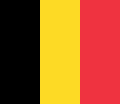Flag of Rwanda
fly side corner | |
| Designed by | Alphonse Kirimobenecyo |
|---|---|
| Presidential standard | |
president of Rwanda | |

The flag of Rwanda (
Details
The flag has three colours: blue, yellow, and green,[1] The light blue band represents happiness and peace, the yellow band symbolizes economic development, and the green band symbolizes the hope of prosperity. The yellow sun with 24 rays represents enlightenment.[2]
The current flag of Rwanda - whose colours resemble those of the flag of Gabon - represents national unity, respect for work, heroism, and confidence in the future. According to the state's official rationale, the flag was adopted (along with a new national anthem at the time) to avoid connotations to the 1994 genocide which it stated the previous one embodied.[3] However, some Rwandans at the time expressed doubts about the reasoning and viewed it as an attempt by the ruling Rwandan Patriotic Front to express its political power by changing state symbols.[4] The flag was designed by Alphonse Kirimobenecyo.[5]
For vertical display of the flag, the Rwandan Olympic Committee has approved showing the obverse of the flag (rotated clockwise 90 degrees.)[1]
Previous flag

Gallery
-
 Flag of the German East Africa Company, flown by early German colonial entrepreneurs in the East African region
Flag of the German East Africa Company, flown by early German colonial entrepreneurs in the East African region -
 Proposed flag of German East Africa which was never used due to the flag being proposed shortly before the outbreak of World War I and Germany's colonies being taken by other European powers after the war
Proposed flag of German East Africa which was never used due to the flag being proposed shortly before the outbreak of World War I and Germany's colonies being taken by other European powers after the war -
 Flag used after the coup of Gitarama (1961) by the republican government during the last year of the Kingdom of Rwanda[7][8]
Flag used after the coup of Gitarama (1961) by the republican government during the last year of the Kingdom of Rwanda[7][8] -
 Flag of Rwanda (September 25, 1961 – October 24, 2001). The official reason given for the 2001 change was to avoid negative connotations associated with the 1994 genocide, although this is disputed by some.
Flag of Rwanda (September 25, 1961 – October 24, 2001). The official reason given for the 2001 change was to avoid negative connotations associated with the 1994 genocide, although this is disputed by some.
References
- ^ a b Flags and Anthems Manual: London 2012 (PDF). London, United Kingdom: London Organising Committee of the Olympic and Paralympic Games. 2012. p. 88. Archived from the original (PDF) on 2015-01-04. Retrieved 4 January 2015.
- ^ a b "Flags of the World: Rwanda". CRW Flags of the World. 20 November 2013. Retrieved 21 February 2014.
- ^ a b Vesperini, Helen (31 December 2001). "Rwanda unveils new flag and anthem". BBC. Archived from the original on 5 November 2003. Retrieved 5 November 2003.
- ISBN 9780299286439. Retrieved 17 September 2021.
- ^ "Flags of Africa — Countries Starting with R". Retrieved 24 March 2014.
- ISBN 9780299286439. Retrieved 7 May 2022.
- ^ Nyrop 1969, p. 23.
- ^ "What Could Have Motivated The 1961 Gitarama Coup In Rwanda?". Taarifa. 6 November 2018. Archived from the original on 7 October 2021. Retrieved 22 September 2021.
- Nyrop, Richard F.; et al. (1969). Area Handbook for Rwanda. U.S. Government Printing Office. OCLC 905626482.
External links
 Media related to Flags of Rwanda at Wikimedia Commons
Media related to Flags of Rwanda at Wikimedia Commons




![Flag used after the coup of Gitarama (1961) by the republican government during the last year of the Kingdom of Rwanda[7][8]](http://upload.wikimedia.org/wikipedia/commons/thumb/4/45/Flag_of_Rwanda_%281959%E2%80%931961%29.svg/120px-Flag_of_Rwanda_%281959%E2%80%931961%29.svg.png)
